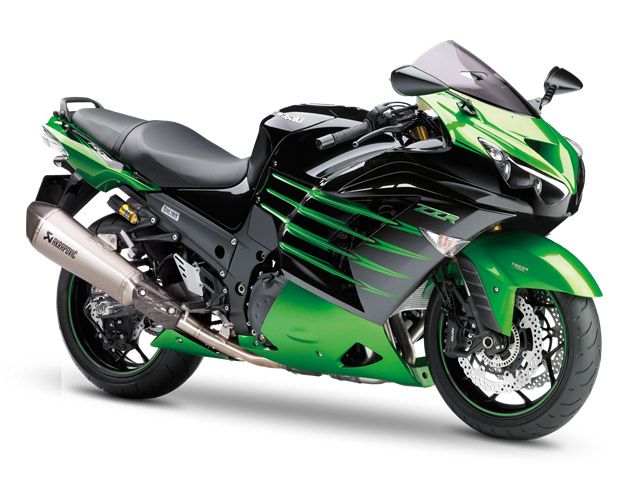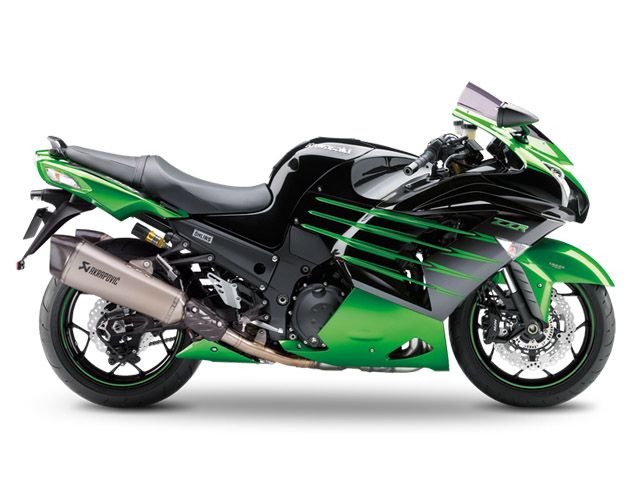The Kawasaki ZZR1400 Performance Sport breaks the boundaries of sport riding, as it is able to impress even the most experienced riders.
With features such as a bespoke Öhlins TTX rear shock absorber, Akrapovic lightweight titanium silencers, and a sporty bubble screen, the Kawasaki ZZR1400 Performances Sport delivers first class riding performances each time you fire up its engine.
Talking about the engine, the Kawasaki ZZR1400 Performances Sport is built around a 1441 cc, liquid-cooled, 4 stroke in line four, DOHC, 16 valves unit which is mated to a six speed transmission. The engine puts out an impressive power of 147.2 KW (200 PS) at 10,000 rpm and 162.5 NM (16.6 KgfM) of torque at 7,500 rpm.
As far as colors are concerned, the motorcycle is available in Golden Blazed Green / Metallic Spark Black.
Hit the jump for more information on the Kawasaki ZZR1400 Performance Sport.
2014 Kawasaki ZZR1400 Performance Sport
- Make: Array
- Model: 2014 Kawasaki ZZR1400 Performance Sport
- Engine/Motor: Liquid-cooled, 4-stroke In-Line Four DOHC, 16 valves
- Horsepower: 200
- Torque: 162
- Transmission: 6-speed
- [do not use] Vehicle Model: Array
Overview
Thrill Seeker
The new ZZR1400 Performance Sport represents an intoxicating blend of engineering, style and performance. Already King of Hypersports, this machine comes equipped with a bespoke Öhlins TTX rear shock absorber and Akrapovic lightweight titanium silencers plus wind cheating bubble screen. Add serious Kawasaki attitude and you have a unique performance and handling package.
2014 Kawasaki ZZR1400 Performance Sport Key Features:
Premium Cockpit
Special edition black meter rings are used instead of the standard pressed stainless steel rings.
New Seat Pattern
Dimpled pattern on the seat material adds to the premium image. Like the standard seat, the new material offers excellent grip, which contributes to the ZZR1400’s sport riding potential.
Bubble screen
Bubble screen windshield enables more comfortable high-speed touring.
Öhlins TTX39 Rear Suspension
Enhancing the already mighty performance of the ZZR1400 is no easy feat. Working together with Öhlins, a top-of-the-line TTX rear suspension unit was developed especially for this model. Renowned for its quality and high performance, the Öhlins shock is an excellent complement to the capabilities of Kawasaki’s flagship model.
Akrapovic Exhaust
Titanium Akrapovic slip-on mufflers contribute to increased engine performance, reduced weight, enhanced exhaust note and a sharper appearance.
Front Fork top caps
Front fork top caps feature the same design as the drilled billet steering stem nut. The caps are finished with gold alumite1, and the markings (“TEN” and “PRELOAD”) are laser etched for a high quality finish.
Power Modes
Power modes offer riders an easily selectable choice between Full and Low Power. While Full Power is unrestricted, in Low Power mode maximum power is limited to approximately 75-80% of Full. Response is also milder in Low Power mode. Riders may opt to use Low Power mode for rainy conditions or city riding, and Full Power when sport riding. Available on the Ninja ZX-14R / ZZR1400, Versys 1000 and other key models, when combined with the 3-mode KTRC (+ OFF) traction control system, Power Mode selection offers a total of eight combinations (KTRC: Mode 1/2/3+OFF x Power Mode: Full/Low) to suit a wide range of riding situations. For example, an experienced rider enjoying sport riding on dry pavement might choose Full Power and Mode 1. On a wet or slippery surface, choosing Low Power and Mode 3 would yield the lowest chance of incurring wheel spin, and with the milder throttle response would offer a high level of riding safety.
Monocoque Frame
Kawasaki's monocoque frame is a hollow composite of aluminium parts. Originally conceived by Kawasaki engineers, it uses the engine as a fixed member so that chassis rigidity is formed not only by the frame, but the combination of the frame and engine together. Joining the engine and front and rear suspension units, the hollow box-style frame envelops the engine from above. In addition to being made from lightweight materials, its main section also acts as the air cleaner box and battery box, enabling parts to be reduced for even greater weight savings. Further, because the frame does not run beneath or alongside the engine, the chassis can be made very compact. Especially on large-displacement models, the slim chassis design of the aluminium monocoque frame contributes to ease of riding. The aluminium monocoque frame was originally developed by Kawasaki in the 1980s for their World Grand Prix works racer. In an era where steel pipe frames were the norm, the aluminium monocoque frame that debuted on the KR500 took the world by surprise. First featured on a mass-production model on the 2000 Ninja ZX-12R, this original Kawasaki technology has evolved and can be found on our large-displacement flagship models.
ABS
Sudden over-application of the brakes, or braking on low-grip surfaces (surfaces with a low coefficient of friction) such as wet asphalt or manhole covers may cause a motorcycle's wheel(s) to lock up and slip. ABS was developed to prevent such incidents. Kawasaki ABS systems are controlled by high precision and highly reliable programming formulated based on thorough testing of numerous riding situations. By ensuring stable braking performance, they offer rider reassurance that contributes to greater riding enjoyment. And to meet the special requirements of certain riders, specialised ABS systems are also available. For example, KIBS (Kawasaki Intelligent anti-lock Brake System) is a high-precision brake system designed specifically for supersport models, enabling sport riding to be enjoyed by a wider range of riders. And by linking the front and rear brakes, K-ACT (Kawasaki Advanced Coactive-braking Technology) ABS provides the confidence to enjoy touring on heavyweight models. Kawasaki is continually working on the development of other advanced ABS systems.
KTRC (3-mode)
3-mode KTRC combines the traction control technology of both 1-mode KTRC, which provides enhanced stability in slippery situations by preventing wheel slip, and S-KTRC, which helps maintain optimum traction in sport riding situations by predicting the rear wheel slip ratio during acceleration, into a single system. The convenient handle switch allows the type of traction control to be changed instantly by selecting one of the three modes, even while riding. Modes 1 and 2 maintain optimum traction during cornering, like S-KTRC. Designed with sport riding in mind, they enable sharp acceleration out of corners by maximising forward drive from the rear wheel. Modes 1 and 2 differ in the amount that they intervene. Mode 1, set for dry, good-grip road conditions, maintains the ideal slip ratio to ensure optimum traction. Mode 3 operates like 1-mode KTRC, reducing power to allow grip to be regained when rear wheel spin is detected. It is ideal when riding in slippery conditions or in the wet. Enabling riders to easily change traction control character, 3-mode KTRC is Kawasaki's most advanced engine management system.
Economical Riding Indicator
Using high-precision electronic control for engine management, Kawasaki models can achieve a high level of fuel efficiency. However, fuel consumption is greatly affected by throttle use, gear selection, and other elements under the rider's control. The Economical Riding Indicator is a function that indicates when current riding conditions are consuming a low amount of fuel. The system continuously monitors fuel consumption, regardless of vehicle speed, engine speed, throttle position and other riding conditions. When fuel consumption is low for a given speed (i.e. fuel efficiency is high), an "ECO" mark appears on the instrument panel's LCD screen. By riding so that the "ECO" mark remains on, fuel consumption can be reduced. While effective vehicle speed and engine speed may vary by model, paying attention to conditions that cause the "ECO" mark to appear can help riders improve their fuel efficiency – a handy way to increase cruising range. Further, keeping fuel consumption low also helps minimise negative impact on the environment.
Dual Throttle Valves
Late-model sport bikes often use large-bore throttle bodies to generate high levels of power. However, with large diameter throttles, when a rider suddenly opens the throttle, the unrestricted torque response is anything but gentle and often more than the rider can handle. Dual throttle valve technology was designed to tame engine response while contributing to performance. On fuel-injected models, throttle bodies generally have only one throttle valve per cylinder. On models with dual throttle valves, there are two throttle valves per cylinder: in addition to the main valves, which are physically linked to the throttle grip and controlled by the rider, a second set of valves, opened and closed by the ECU, precisely regulates intake airflow to ensure a natural, linear response. With the air passing through the throttle bodies becoming smoother, combustion efficiency in improved and power is increased. Like other Kawasaki engine management technology, Dual Throttle Valves were designed with the philosophy of "following the rider's intention, while providing natural-feeling support." They are featured on many Kawasaki models.
Specifications
|
Engine type |
Liquid-cooled, 4-stroke In-Line Four |
|
Displacement |
1,441 cm³ |
|
Bore x stroke |
84.0 x 65.0 mm |
|
Compression ratio |
12.3:1 |
|
Valve/Induction system |
DOHC, 16 valves |
|
Fuel system |
Fuel injection: ø44 mm x 4 (Mikuni) |
|
Ignition |
Digital |
|
Starting |
Electric |
|
Lubrication |
Forced lubrication, wet sump with oil cooler |
|
Maximum power |
147.2 kW 200 PS / 10,000 rpm |
|
Maximum torque |
162.5 N•m 16.6 kgf•m / 7,500 rpm |
|
Maximum power with RAM Air |
154.5 kW 210 PS / 10,000 rpm |
|
Transmission |
6-speed, return |
|
Final Drive |
Sealed chain |
|
Primary reduction ratio |
1.556 (84/54) |
|
Gear ratios: 1st |
2.611(47/18) |
|
Gear ratios: 2nd |
1.947 (37/19) |
|
Gear ratios: 3rd |
1.545 (34/22) |
|
Gear ratios: 4th |
1.333 (32/24) |
|
Gear ratios: 5th |
1.154 (30/26) |
|
Gear ratios: 6th |
1.036 (29/28) |
|
Final reduction ratio |
2.471 (42/17) |
|
Clutch |
Wet multi-disc, manual |
|
Frame type |
Monocoque, pressed-aluminium |
|
Rake/Trail |
23°/ 93 mm |
|
Wheel travel, front |
117 mm |
|
Wheel travel, rear |
124 mm |
|
Tyre, front |
120/70ZR17M/C (58W) |
|
Tyre, rear |
190/50ZR17M/C (73W) |
|
Steering angle, left / right |
31°/ 31° |
|
Brakes, front Type: |
Dual semi-floating 310 mm petal discs Caliper: Dual radial-mount, opposed 4-piston, 4-pad |
|
Brakes, rear Type: |
Single 250 mm petal disc Caliper: Opposed, twin-piston |
|
Suspension, front Type: |
43 mm inverted fork with top-out springs Compression damping: 18-way Rebound damping: 15-way Spring preload: Fully adjustable |
|
Suspension, rear |
Bottom-Link Uni-Trak, Öhlins TTX39 rear shock with piggyback reservoir and remote preload adjuster Compression Damping: 22-way Rebound Damping: 22-way Spring Preload: Fully adjustable |
|
Dimensions (L x W x H) |
2,170 mm x 770 mm x 1,170 mm |
|
Wheelbase |
1,480 mm |
|
Ground Clearance |
125 mm |
|
Fuel capacity |
22 litres |
|
Seat height |
800 mm |
|
Curb Mass |
268 kg |
|
Color |
Golden Blazed Green / Metallic Spark Black |
|




